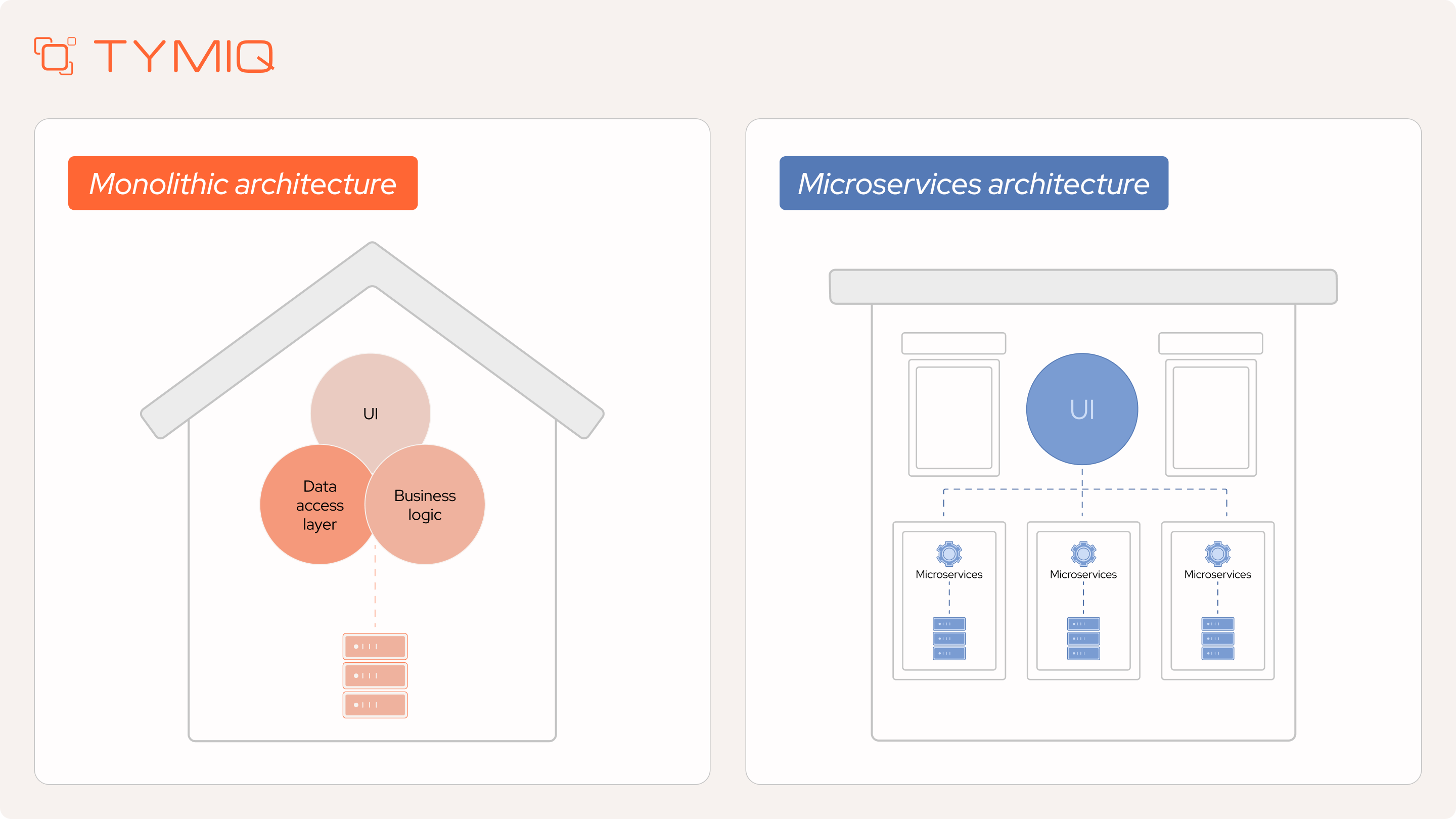Many companies today still operate monolithic Java applications that have adequately supported their operations for many years. Though monolithic architectures sometimes have a negative connotation, advantages such as ease of development, efficiency in performance, and low operational overhead still apply. Unfortunately, as a company grows, some monolithic apps could become difficult to scale, complex to maintain, and costly to change.
Microservices are often presented as the default solution to these challenges. By breaking down a monolithic application into smaller, independently deployable services, microservices promise greater flexibility, scalability, and resilience. Think of it like a large, multi-generational family moving from a single, shared house to separate apartments, where each household has its own space and autonomy.
The first thing to understand is that moving to a microservices architecture is not a universal solution. In certain circumstances, it may be cheaper and simpler to maintain or strengthen some elements of an existing monolithic architecture than to undertake a full-scale migration.
In this article, we will explain the concept and process of modernizing Java applications, not assuming that microservices are the easy answer but evaluating when and how they do provide real business value.
What are microservices?
Microservices can be defined as an architectural style where an application is broken into bounded contexts (microservices), each serving a specific business function and loosely coupled with other parts of the system. Different from monolithic applications, which bundle everything within one package, microservices help teams develop, test, deploy, and scale different parts of an application independently.

A microservice is not one deployable unit; instead, it may involve multiple processes that work jointly within the same bounded context. For instance, consider that an order-processing microservice would include a RESTful API for accepting requests and a scheduled job for scanning and updating order statuses. While sharing one domain, these various components work as independent deployable processes.
Microservices communicate over APIs or messaging systems, and each may or may not have its own dedicated database. This modularity increases agility, enabling teams to update, deploy, or scale specific functionalities without disrupting the entire system.
When to modernize a monolithic application to microservices?
Not all monolithic applications are bad by nature, nor is an immediate transition to microservices the best solution. However, as a business expands, some monolithic architectures begin hurting scalability, agility, and security. Knowing at what juncture to modernize a monolith becomes vital to guarantee that any change undertaken gives real business value.
One of the biggest limitations of monolithic systems is scalability. Since all components are coupled so tightly, scaling would mean scaling the whole system even if only one part of the application requires additional updates. The 51% of respondents by Gartner report said that there saw improvements in the application scalability in the organizations after implementing the microservices architecture.
The next critical factor is development speed. When every change, no matter how small, requires redeploying the entire application, release cycles slow down dramatically. In contrast, microservices applications are built to allow parallel development so that different parts of the system can be developed and tested independently. This speed gap can be a competitive advantage for microservices applications, especially in fast-moving industries.
Security is another growing concern with monolithic architectures. If a single vulnerability exists in any component, the whole system may become compromised, giving rise to the risk of a security breach. Application security patches and updates are also challenging to apply, because they require the redeployment of the entire application, which delays responding to a new threat.
Let’s take into account that according to IBM's 2024 Cost of a Data Breach Report, the global average cost of a data breach reached $4.88 million in 2024, a 10% increase from the previous year, highlighting the escalating financial impact of security incidents.
Some monolith applications, in fact, do not necessarily have to be modernized immediately. These monoliths can be efficient, cost-effective, and fit for whatever business application. Transitions to microservices would then grant increased agility, resilience, and optimization when systems suffer from scalability, long-release cycles, or security risks. A carefully planned modernization strategy ensures that the long-term benefits outweigh the costs.

Is microservices architecture the right choice for you?
Microservices are no doubt a powerful paradigm, but they also come at a cost. Unlike monolithic applications, which operate as a single unit, microservices introduce additional complexity in deployment, monitoring, and communication between services. This means transitioning from a monolith should not be a decision taken lightly—it requires careful planning and a clear understanding of the trade-offs.
Microservices are best suited for large-scale applications that require high scalability and flexibility, such as e-commerce platforms, streaming services, or large healthcare systems. That way, they provide the ability to scale components independently, improve system reliability, and leverage cloud-native technologies.
However, not all applications require a microservices architecture. Smaller applications, minimum viable products (MVPs), and in-house tools might do perfectly with a monolithic architecture. A shift has to take place under clearly defined business needs and technical requirements, not by trends. You might want to reconsider the migration if:
- Different parts of a monolith system should be scaled differently.
- Release cycles of different modules within the monolithic system vary.
- The monolithic system implements requirements across multiple bounded contexts or subdomains.
- Teams working on the monolithic system struggle with complexity and interdependencies.
- Teams would like or must use different technology stacks for different modules.
If your organization lacks the internal resources for such a transition, consulting with a software modernization expert can be a valuable step in ensuring a smooth migration.
Monolith to microservices migration: The steps
Now that you're convinced that the move from a monolith to microservices is needed for your business, below are the steps that will assist you in carrying out the transition.
Could you imagine a huge family living in one old house across multi-generations? Over time, the house has become crowded; new generations came in, rooms got remade, and any change would impact everyone. Expanding or renovating the house was difficult because every part was intertwined, from shared utilities to a single kitchen which became the lifeline for all. At last, they agreed upon a decision: moving into separate apartments, where each household had its own space, independence, and growth, without disturbing the others.
Similarly, a monolithic application is successful at first, but it grows rigid when you want to incorporate other features into the framework. Moving from a monolith to microservices is like turning a family into separate apartments: each (or a household) gains the complete authority of living/operating on its own, while enabling it to communicate well. The movement requires careful planning and setting all things together: restructuring and setting up another working system.
Analyzing and planning
Deciding which of the family members will move into separate apartments first
Before splitting up family members into separate apartments, establish how it has been functioning as a unit, who needs shared spaces, which responsibilities overlap, and who can operate independently. Some family members may be up for moving on the spot, while others are still very much tied to the home.
Just like in application modernization, the first step is not about analyzing the code; it lies within understanding the business domain. Teams are to identify bounded contexts-those discrete domains of the business that may operate independently. The focus should not be on breaking the system into services purely from a technical standpoint; defining coherent business capabilities becomes the core point, which should be separated without affecting critical workflows.
However, not all business functions and processes need to be shifted at the same time. Some would naturally be more independent and lend themselves as initial candidates for migration. Those domains that are least interdependent should be prioritized for later to reduce risks and make transition smoother.
Decomposing the application
Dividing the old house into individual living units
While families are packing up, they realize that some of their shared spaces, for example the large communal kitchen, must now be divided into individual ones for each household. Thus, families separate their belongings, leaving only what they will need in their new houses.
In the same way, within a monolithic application, there are tightly coupled components which need to be decomposed into smaller, self-sufficient services. Functional decomposition makes each one of the microservices responsible for their work, just as each family would have to set up its own living space without relying on the old, shared kitchen.
Adopting the right frameworks for microservices
Choosing the right infrastructure for each apartment
Once the family has moved into separate apartments, they should equip it with essential utilities—those basic ingredients to running independently—that is, electricity, gas, plumbing and Internet.
For the microservices architecture, this means using lightweight frameworks provided by the clouds, such as Spring Boot, Quarkus, or Micronaut, to enable each service to be tuned for its own independent operation.
Defining service boundaries
Ensuring each apartment has its own walls and utilities
In an old house, space and things were mostly common—people may have moved around borrowing things or sharing cupboards with other members. In the new apartments, every family has its own things, walls, doors, and utility bills.
While it is advantageous to define service boundaries this way, it also protects the microservices, enabling maintenance to occur on only one service without threatening the overall system. This is just like a family that has to redo their kitchen, starting work without even thinking about their neighbors whom they could face.
Splitting a centralized database
Ensuring each apartment has its own grocery storage
It was a common practice in the family to have a massive pantry storing food; anyone could use whatever they needed from the storage, but it sometimes led to conflicts. Each apartment today possesses its refrigerator and storage, thereby restricting reliance.
This is the same as when working within a monolithic application. Scaling individual parts of a centralized database usually becomes a headache. With moving to microservices, you will get the database fragmented into manageable databases, each of those small databases working for a specific service, with dedicated data storage without any possibility of overlapping. This is just like each individual apartment receiving its groceries.
Nonetheless, microservices often still need data from other services. Since directly querying another service's database would violate independence, you can consider the following various options exist:
- Replication of databases: Some of the data can be replicated across the microservices using event-driven mechanisms (Change Data Capture (CDC)) for various databases to be in sync. For example, if the customer billing service modifies subscriptions, a copy of that will also be reflected in the user service without having to access the billing database directly.
- API-based data access: A microservice should request data from RESTful APIs or GraphQL instead of directly querying another database. This will ensure that communication happens without tightly coupling their databases.
- Event-driven messaging: Microservices subscribe to events using event brokers like Kafka or RabbitMQ and can then update their local databases on demand. For example, when an order is placed, the inventory service listens to that event and updates stock levels accordingly.
By the way, should each microservice have its own database? TYMIQ held a workshop with an invited speaker, considering different microservice-based systems and the feasibility of having a database for each microservice. Watch the recording of the workshop below.
Establishing communication mechanisms
Setting up a communication system between apartments
Back in the old house, communication was simple: family members simply shouted across the hallway. Now, living in separate apartments, they need better communication strategies—be it phone calls, WhatsApp messages, or an intercom system.
In microservices, direct method calls, as often seen in a monolithic application, are to be replaced by more resilient and scalable means of communication. Although REST APIs and gRPC come in handy while making service-to-service calls, inadequate synchronous communication can transform a microservices architecture into a distributed monolith with tight coupling and interdependencies among services.
In order to prevent the anti-pattern of a distributed monolith, microservices use event-driven communication via asynchronous messaging queues (like Kafka or RabbitMQ) to avoid blocking execution for information exchange. This means that even if one service is down temporarily, others can still continue to work unhindered. The API Gateway acts as an intercom in the building to direct communication across services, addressing such issues as authentication, rate limiting, and logging.
Why transition from monolithic to microservices with TYMIQ?
Migration of monolithic applications to microservices takes great knowledge and capabilities to be successful, similar to how families rely on moving companies for relocation services to relieve their stress. TYMIQ is such a moving company for those organizations that are interested in modernizing their applications into microservices. We provide:
- Comprehensive modernization support – Our guidance extends from the initial assessment until the final deployment process.
- Cloud-native expertise – We help you implement containerization, Kubernetes, and DevOps best practices to optimize your microservices.
- Tailored solutions – Our customized approach is aimed at your specific business needs, keeping disruptions to a minimum and productivity to a maximum.
The bottom line
Transforming a monolithic Java application into microservices is a strategic step toward improved scalability, agility, and maintenance in the long run. That’s why this transition has to be planned carefully, just as moving from a common house to separate apartments would require proper strategizing. Though it is a lot of work, the final benefit of increased independence, efficiency, and resilience calls for the interest.
You can ensure a smooth and successful transition through assessing your application's readiness, defining service boundaries, and adopting cloud-native best practices. If you're ready to go on this journey, TYMIQ is here to help. Contact us today at contact@tymiq.com to brainstorm your modernization initiative.
FAQ
1. What are microservices in Java?
Microservices in Java is an architectural style wherein Java applications are broken down into small, self-contained services communicating over the network. Each microservice is dedicated to a single business function and thus, can be developed, deployed, and scaled on their own.
2. What are monolithic applications?
Monolithic applications refer to the traditional software in which components such as UI, business logic, and database are closely linked within a single large codebase. Developers need to maintain, build, and scale the monolithic unit as a whole.
3. What is the difference between monolithic applications and microservices application?
A monolithic application is a single, unified system that integrates every component (such as the user interface, business logic, and database) together into one codebase. Altering any part of the system necessitates changing the entire application because any new feature or functionality requires sending out these changes in the whole system. This makes monolithic architectures challenging, as any change—no matter if it is very minor—in any element will prompt a complete deployment. Also, a failure in one component can damage the entire application.
On the other side is a microservices application, which is built of a few independent services carrying specific tasks. These services engage each other across the APIs, and they can be built, deployed, and run at their respective scales. This way, the architecture supports more freedom to upscale individual components, introduce new functionalities, and make changes within the system without affecting the entire application. Evidently, if one service crashes, it does not affect the entire system, thus boosting the overall system resilience.










.svg)

